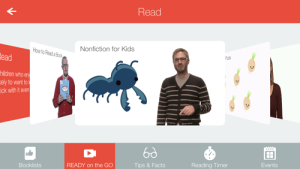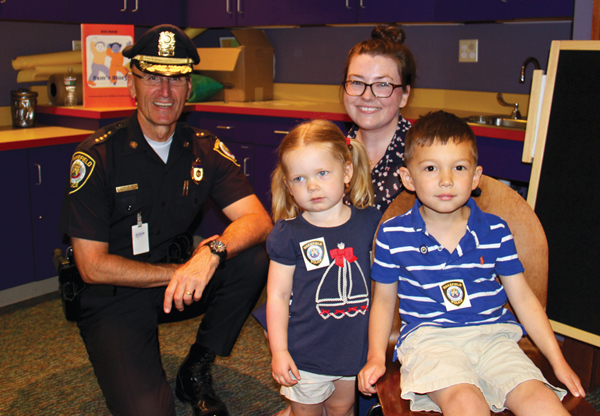
The news stunned our town of Wakefield, Massachusetts in December 2012: The spouse of an unlicensed home daycare owner was accused of sexually assaulting 13 children between 8 days and 4 years of age. District Attorney Gerry Leone called it the worst case he had seen in 14 years. Leone filed more than 100 charges against the sex offender, who videotaped some of the assaults, including multiple counts of aggravated, forcible rape of a child and indecent assault and battery on a child.
This case fueled talk in the community for months. However, on the heels of the Boston Marathon bombings four months later, much of the talk dissipated. Community leaders became concerned that the issue of child sexual abuse would take a back seat to newer—more sensational—news, and lose focus within the community, leaving abuse to perpetuate. To keep the discussion of violence against children in the forefront, Rotary Club of Wakefield joined forces with the Wakefield Police Department, Children’s Trust, Wakefield Alliance against Violence, YMCA, and Lucius Beebe Memorial Library to form a Child Safety Committee. The committee resolved to offer preventative programming throughout the town to raise awareness about violence and its effects.
After one of the early committee meetings, Sharon Gilley, our library director, asked youth services staffers if they could put together a story hour with a child abuse theme. Keywords that patrons generally associate with storytimes include “entertaining,” “fun,” and “educational.” The contrast between those terms and child abuse seemed too broad a chasm to bridge. While our initial reaction was, “That’s not our job,” we realized that other civil servants—police, social workers, teachers—and parents were already stressed, overworked, and undersupported. Our response then became, “If not us, then who?”
Gilley received a “Talking About Touching” (TAT) curriculum from Rotarian Amy Luckiewicz and arranged a training session on implementing it. TAT teaches children how and when to begin a dialogue with their “trusted adults” about all aspects of their personal safety. Lessons in the curriculum are strategically layered to present less threatening material in the beginning, allowing children to acclimate to the librarian and establish a level of safety and trust. The topics grow in intensity over the course of the program. TAT prescribes child-friendly language to describe a number of dangerous situations, including safe, unsafe, and unwanted touching.
According to TAT, children under the age of 5 are the most vulnerable to child abuse, as they do not have the language skills to describe what happens to them, nor do they know to question the actions of caregivers. Abusers potentially exist in all facets of a child’s life. US Department of Health and Human Services statistics for 2011 say that more than 80% of perpetrators of child maltreatment are parents. A majority of child victims, 73%, do not tell anyone about the abuse for at least a year, resulting in increased vulnerability to revictimization. Only 2% of child sexual abuse takes place in a daycare setting.
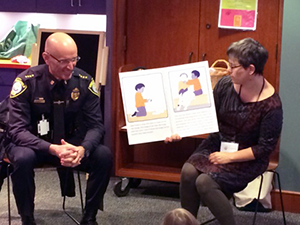
As child advocates, we found these grim realities hard to ignore. We had to reassess our roles as activists. Children’s librarians come with built-in credibility. We’re a known and trusted entity in the community. We already have relationships with children and their families. Taking a leadership role in child safety benefits libraries and the public.
The public library is uniquely positioned to deliver this service. First, public library policies favor free speech. As First Amendment advocates, librarians are free to say the words “penis” or “vagina” in an educational program. Second, libraries demonstrate a trusted and proven track record in delivering children’s programs, especially for preschoolers. How often can we say that a library program meets such a crucial moral imperative?
After the initial training, staffers brainstormed in earnest about delivering a library program. Was the topic too weighty? Would we come off as preachy? Would this topic engage young children? Would we alienate parents? Could we find sufficient activities and books to support a preschool program? Would staff be comfortable with the subject matter? How would we make room for a new program? The Youth Room staffers already had a very heavy programming workload. We wondered if we would have the time to prepare for a totally new program.
Staff members began condensing an 18-week lesson plan designed for schools into a six-week program that would be manageable for parents of preschoolers. We scoured bibliographies for books that would address the themed lessons: car and fire safety, helping a child know what to do if lost (“getting found”), gun safety, and touching safety.
Then the search for booster activities began: songs, poems, finger plays, games, props, puppets. Every week, staff members provided interactive components supporting each individual theme. In order to engage young children, interaction was critical.
The final large challenge was library policy. Librarians are not “mandated reporters”—people who are legally required to report abuse if observed or suspected—nor should we be. We have no custodial roles, as schools do. We do not operate in loco parentis. Patrons have a right to confidentiality, and mandated reporting provides an uncomfortable, if not impossible, conundrum. In response to this programming, Beebe’s library trustees passed a policy stating that a librarian may file a Massachusetts 51A form (report of child alleged to be suffering from serious physical or emotional injury by abuse or neglect), if he or she deems it necessary. The last puzzle piece for implementation was in place.
“The groundwork was laid. In a way, the stuffy library stereotype is the perfect foil for activism,” Gilley says. Libraries are a safe place to confront taboo subjects. We are credible and trusted. We’re a familiar gathering and learning place. Participation is voluntary. We are responsive to our community.”
Children’s librarians are a known and trusted entity in the community and come with built-in credibility.
We offered the first two sessions of the “Keep Me Safe Story Time” program in September 2013. It was offered to children aged 3–5, without parents or caregivers in the room. Parents could wait in the adjacent area where they could monitor the program through windows. Advance registration was required, with a 10-child limit. Parents committed to having their children attend all six meetings, as the information built from week to week.
Some parents initially expressed concern about leaving a 3-year-old in a program without them, but all understood the importance of children learning from a trusted authority on this topic. One parent feared that her child was not yet ready to be separated from her. Another worried that the presentation might be too dramatic for her son, who had taken a child safety workshop at his school and become anxious about strangers as a result. The librarians shared the books to be used in the storytime and reviewed the curriculum and materials with her in advance to assuage her concerns. After each session, parents received a letter summarizing the lesson and suggesting follow-up activities to do together.
Before having her three children, Beebe patron Heather Kelley was a registered nurse and sometimes worked with children and adolescents with histories of abuse.
“I had started planting seeds with my children about ‘stranger danger’ and ‘safe vs. unsafe touches’ a very long time ago. I felt that it was important they be taught as soon as possible about these things so that if the unthinkable were to happen, they would be able to recognize (and hopefully avoid) an unsafe situation,” she says. “At the same time, I often considered that perhaps my nursing background was causing me to be overly concerned or possibly paranoid, and that perhaps I was giving them too much information at too young an age. I worried that maybe instead of protecting them I was going to end up scaring them and causing them to be overly fearful.”
After attending a “Keeping Kids Safe” workshop for parents at the library, Kelley was excited to bring her 3- and 5-year-olds for the storytime. “I was sure that the content was going to be helpful and valuable,” she says.
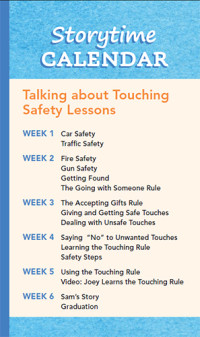
The first storytime meeting covered car and traffic safety. By and large, children knew all the right responses to questions about the subject, and they gained a measure of confidence in feeling like experts. Week two moved on to fire and gun safety, and what to do if separated from a caregiver.
Week three introduced the “Ask First” rule. This rule helps reduce the risk of predatory grooming by communicating with a caretaker about secrets, presents, and rewards. Children learned to use this rule as a response to someone, stranger or known, asking them to go somewhere or to accept a gift. This was a subtler message, as a gift of cookies offered by a neighbor seems innocuous and is commonplace. But the idea is to always gain permission so that parents know who is interacting with their children.
We talked about safe and unsafe touch during week four: giving and getting unsafe touches, dealing with unsafe touches, and saying “no” to unwanted touches. Children learned to think about their own actions as well as the actions of others. It is powerful and important knowledge for children that their words can have an impact on what others do to them.
In week five, it was imperative to make sure that children understood the Touching Rule: “Say no, then go and tell someone.” Children learned which parts of the body are private: the parts covered by a bathing suit or underwear. They learned who may touch private body parts: only someone who is keeping them clean and healthy. Children also learned that it is never the child’s fault when an adult breaks the Touching Rule, to always tell a touching secret, and to keep telling until they get help. The Touching Rule applies to strangers, friends, and family. In storytime, children practiced how to say “no” in various scenarios, with prompting and hypothetical questions from the librarian and from a puppet, Rocky, a shy raccoon residing in a trash can.
The children graduated in week six. Chief Rick Smith of the Wakefield Police Department was our guest speaker. He reviewed safety rules with the group and awarded certificates of graduation. The children were so excited that the chief was there. At the reception afterwards, we celebrated the kids’ newly learned confidence in preventing unsafe behavior.
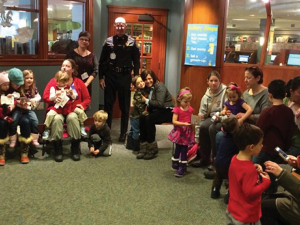
“Each day children become victims of abuse, usually harmed by aggressors they know. ‘Keep Me Safe Story Time’ provides a guided curriculum and educates both child and parent about how to best prevent abuse,” Rotarian Luckiewicz says. “Incorporating all types of prevention, touching safety becomes a standard in a participants’ toolbox of skills. By learning the Touching Rule and following the Safety Steps, young children are empowered to help protect themselves and become assertive.”
Public response to this program has been overwhelmingly positive.
“I believe that teaching about personal safety in the context of all safety issues helps to normalize talking about it and makes it less taboo,” Kelley says. “I had been so worried about my children being harmed or kidnapped or abused by somebody that I had not even thought about starting serious learning with them about fires, matches, or guns. This was a helpful bonus, because I now had a platform to begin teaching safety in regard to these issues.”
She adds that the program helped her feel validated to learn that what she had started teaching her kids at home was right, and that they were not too young to start learning it; relieved at having partners in the librarians she and her family already knew and trusted; and empowered in the tools and information they received along the way.
“If every child learned what was in this course, the world would be a safe place,” says Patrick Curley, whose son Alan participated in the story time. “More children should enroll. Kids at this age learn from repeated messages coming from [parents] but also from other authority figures—teachers like (Beebe’s former children’s librarian) Allison and Chief Smith.”
Curley’s wife wife got a reference from the library to another past graduate’s parent so that they could confirm that the subject matter was not overwhelming and terrifying. “The parent was very enthusiastic so we signed Alan up. Maybe other parents will see this and sign up their kids in the future,” Curley says.
The youth services staffers keep a roster of parents who are interested in participating in the “Keep Me Safe” series. The staff members review and revise the lessons based on how effectively the groups learn. While the curriculum states appropriateness for children as young as three, remedial work needs to be done with some of the younger children.
The “Keep Me Safe” program is still a work in progress. As we evaluate the effectiveness of communicating the lessons to children, we continually update our methods and restructure as needed. We anticipate offering this program for years to come.

